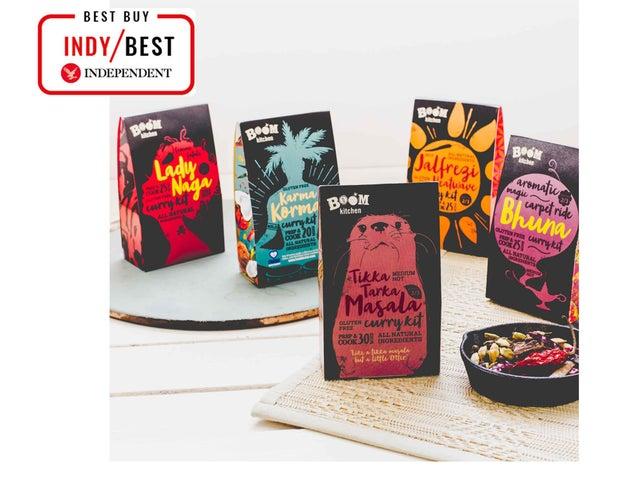
The Independent's journalism is supported by our readers. When you purchase through links on our site, we may earn commission. Why trust us?
National Curry Week: 8 best curry kits to help you make restaurant-quality dishes at home
Turn up the heat in the kitchen without forking out for endless ingredients
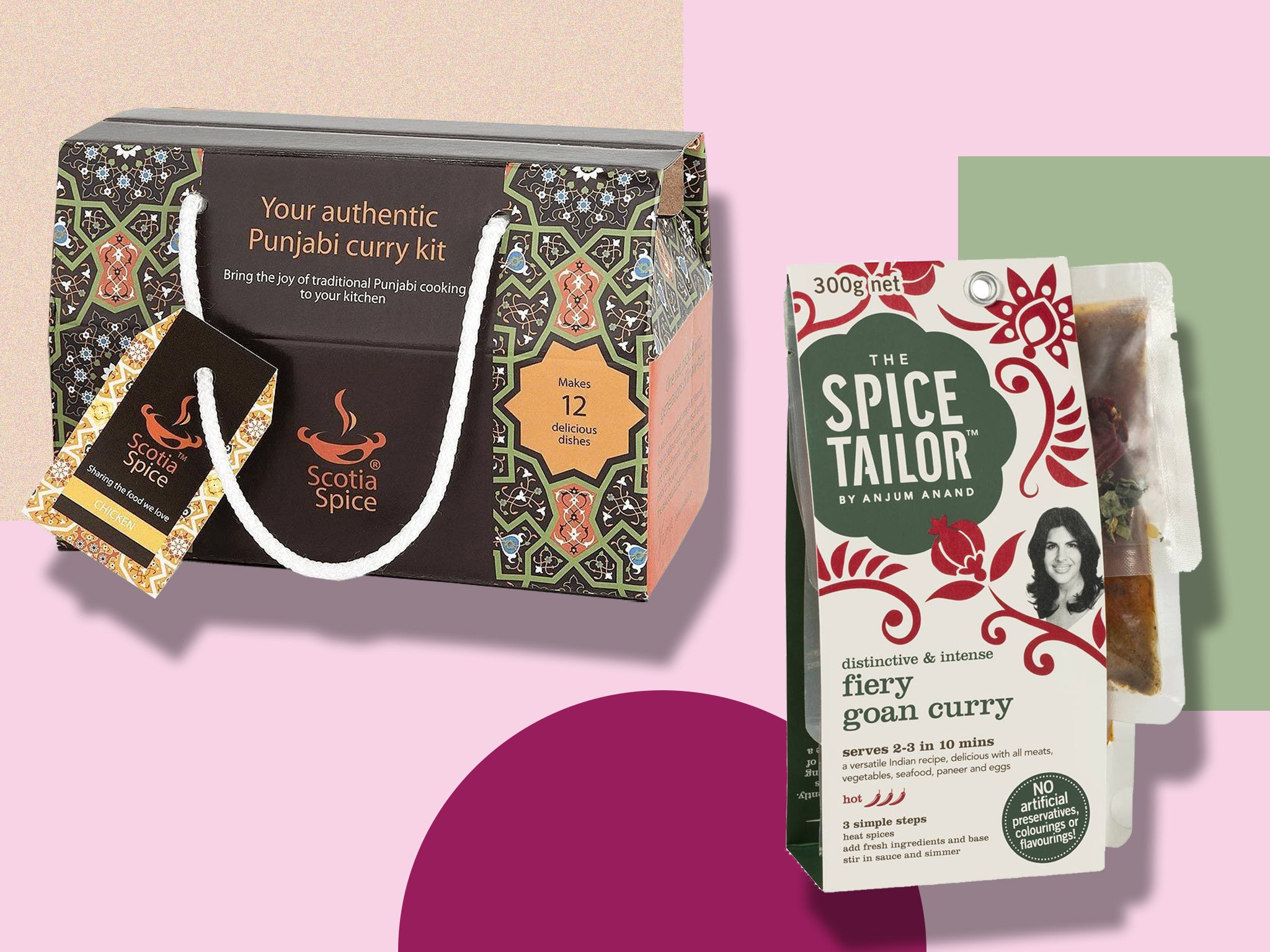
Everybody loves a Ruby Murray, don’t they? No longer confined to a Friday night, lots of us enjoy cooking up a spicy storm in the kitchen any night of the week – and increasingly we’re using specially designed kits to do so.
The cost, quality and ease of use of curry kits vary wildly, but their universal benefit is that it saves buying hoardes of different spices – which can be tricky to get hold of some cases – and hands you the perfectly measured amount of Kashmiri chilli, brown mustard seeds or fenugreek required for the recipe, with no waste.
Of course, keen cooks could spend a happy hour or two knocking up their own version of butter chicken or beef rendang using a stuffed store cupboard of spices, or at the other end of the spectrum there are supermarket pastes and sauces that will provide you with a middling jalfrezi in about 20 minutes, but these kits fall into a separate sphere where the curious can create dishes well outside of their comfort zone with very little fuss and almost guaranteed success.
To be considered a “kit” we were looking for at least two components, though some had many more, along with steps to follow and actual cooking to do.
Whether you’re after a quick post-work supper or are game for a veritable banquet, there’s a curry kit for that.
Read more:
How we tested
With more than a month of testing, 20 hours spent cooking and 28 different dishes, we’ve put the best to the test and these are our hot picks.
The best curry kits for 2021 are:
- Best overall – Boom Kitchen pick 'n' mix flexible subscription: £14, Boomkitchen.co.uk
- Best Sri Lankan curry kit – Hari Hari 6 pack curry kit: £20, Harihari.co.uk
- Best subscription box – The Spicery three month Indian restaurant favourites subscription: £26, Notonthehighstreet.com
- Best weeknight curry kit – The Spice Tailor fiery Goan curry: £2.95, Tesco.om
- Best for vegetarians – Hari Ghotra tikka masala: £3.50, Harighotra.co.uk
- Best for curry lovers – Scotia Spice chicken curry kit: £24.95, Scotiaspice.co.uk
- Best low calorie curry kit – Spicentice Malaysian rendang: £2.49, Spicentice.com
- Best value – Waitrose Cooks Ingredients massaman Thai curry meal kit: £3.50, Waitrose.com
Boom Kitchen pick 'n' mix flexible subscription

Best: Overall
For anyone looking to recreate a British Indian curry house experience, this is where we’d direct you. With varieties such as “jalfrezi heatwave”, “lady naga” and “karma korma” to choose from, the kits contain three or four sachets of spice mixes, stocks, dried chillies or coconut and usually around four very easy steps to create a restaurant-quality meal for four. All the varieties are vegan friendly and though most kits suggest chicken as the main protein, further suggestions are available online.
We thought the “jalfrezi heatwave”, which we made with lamb and a handful of other fresh ingredients, was terrific and really had that authentic je ne sais quois, which is often lacking from homemade curries. Though the spice blends mean you’re not entirely sure of measurements to recreate dishes alone – it’s not just whacking in a paste and frying – there is enough participation in the cooking process to make you proud of your achievement. Most of the dishes take around 25 minutes and can be purchased separately outside of the subscription model if you like, though we’d highly recommend the pick’n’mix option and hosting a big curry night for all your friends.
Hari Hari 6 pack curry kit
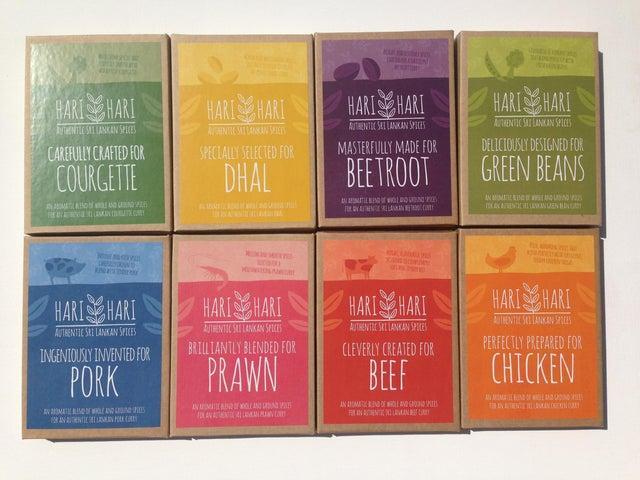
Best: Sri Lankan curry kit
Hari Hari is a range of 10 Sri Lankan curry kits designed to help you create authentic curries based around one main ingredient; choose from courgette, pork, chicken, or prawn curries and add the handful of fresh extras (usually onion, ginger and coconut milk) to make healthy, aromatic dishes for around four people a time. Most packs contain three sachets of whole or ground spices imported from Sri Lanka and hand blended by Hari Hari creator Illana Smith, who is half Sri Lankan and grew up there. We thought the chicken curry was absolutely delicious with crowd-pleasing rich and warming spices tempered with the characteristic Sri Lankan coconut flavours and paired brilliantly with the green bean curry kit which provided a fresh and vibrant contrast. Sri Lankan curries are typically complex, so these spice kits offer a welcome introduction to cooking the cuisine; the adventurous could branch out to the hopper mixes available too.
The Spicery three month Indian restaurant favourites subscription
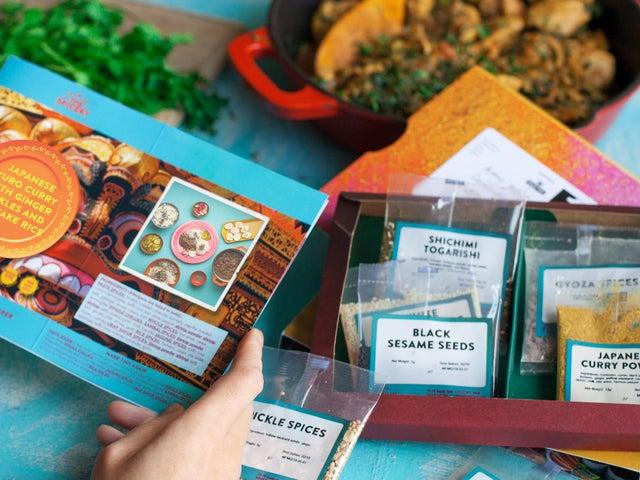
Best: Subscription box
These were one of the first kits on the scene and they’re still going very strong. The brand’s MO is that you sign up for a monthly letterbox delivery of freshly ground and measured spices along with a recipe card and shopping list of the fresh ingredients required to create around four complementary dishes. Choose from themes like “world kitchen explorer”, “Indian restaurant favourites” and the one we’d recommend, “Friday night curry discoverer” which brings curries far and wide to your door – past examples include Japanese kuro curry with soy eggs and pickles, and Goan xacuti with pilau.
We made a heady, clove scented Zanzibari chicken biryani with date chutney, coconut dhal and chilli salt fruit which went down brilliantly on a Friday night with friends. Novice cooks may find juggling cooking three or four dishes at the same time daunting, but the recipes are simple and as long as you have a modest range of kitchen equipment (we needed a blender, for example) then you will be serving up exotic feast after feast in no time at all. Packaging is compostable and you can keep the cards and repurchase spice blends or buy your own to make your favourites again.
The Spice Tailor fiery Goan curry
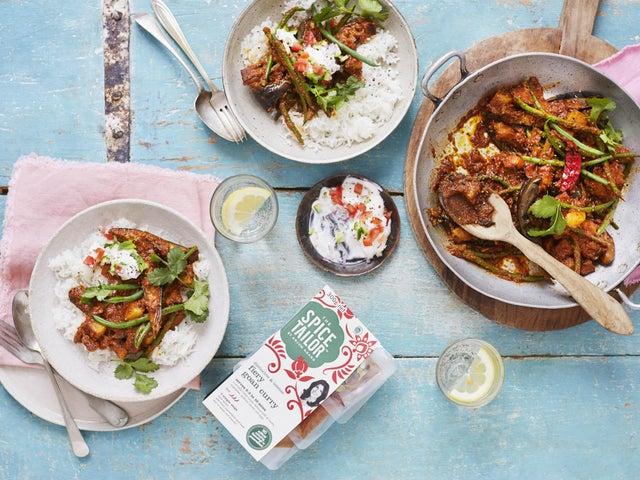
Best: For a quick weeknight dinner
This range is prevalent in supermarkets and for good reason; offering a wide selection of Indian curries using pastes, marinades, spices for sprinkling and sometimes an accompanying chutni (Indian spelling) ready in as little as 10 minutes. We tried six kits in the range and were hugely impressed by the tasty daals which can be whipped up in five minutes thanks to the pre-cooked lentils, but the favourite we settled on was the fiery Goan curry with a distinctive tomatoey-vinegar base which required only one fresh ingredient purchase – we plumped for haddock – and had on the table in no time at all.
Each kit has suggestions for a main ingredient such as chicken, prawns or vegetables (these kits are good for vegetarians) and inside there are variations on the recipe, encouraging you to add spinach, whole chillies or a crispy onion garnish should you have extra time. For a fast weeknight dinner these are a godsend and the end results certainly taste authentic on a level with many of the other dishes we made, but because you’re using a paste and not doing much in the way of cooking or learning about how to use specific spices these may not be for keener cooks.
Hari Ghotra tikka masala
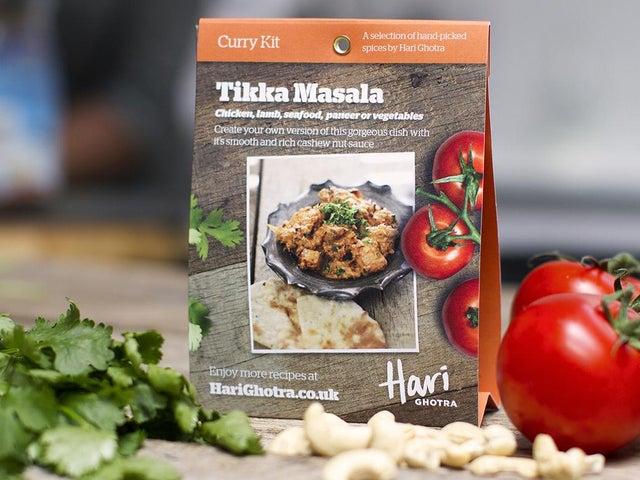
Best: For vegetarians
Indian chef and blogger Hari Ghotra has created a range of 12 popular curry house favourites – think bhuna, makhani, korma – in kit form comprising a number of mini spice bags ready to be ground, soaked or fried according to her instructions. Most recipes need a spice grinder/pestle and mortar and about half a dozen fresh ingredients to create the dish – a protein, then perhaps onion, ginger, yoghurt etc – and are a tad more time consuming than some of the other kits in this list, but they are very much worth it. We tried a few in the range, but were blown away by the success of our chicken tikka masala, which easily rivalled most curry houses’ and outclassed previous time-consuming attempts at cooking the dish from scratch.
The depth of flavour and that hard-to-achieve smoky flavour combined with the classically rich and creamy masala was remarkable and we’ll be purchasing this particular in bulk and avidly cooking our way through the rest of the range too. Another good one for vegetarians, as Hari suggests paneer, aubergine and other non-meat ingredients as the star of the show. Each kit also includes a QR code to watch Hari cooking the dish along with you.
Scotia Spice chicken curry kit
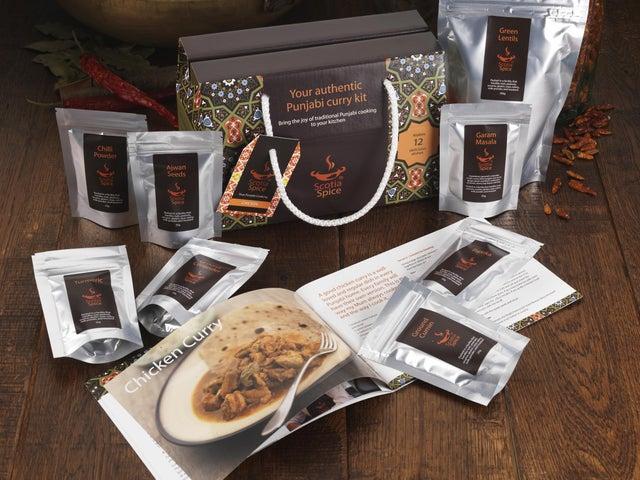
Best: For curry lovers
For the fully-invested curry lover, look to Scotia Spice for an education in how to use individual spices. This kit contains six recipes with essential spices and dried ingredients like lentils, but most valuably a guide to tasting individual spices and far more tips and techniques than others on the market, unsurprising when you consider this kit is born out of cookery school owner Yasmin McDonagh’s determination to bring the Punjabi food of her childhood to the masses.
The recipes are easy to follow and mouth-wateringly delicious; we thought the chicken curry was exceptional (it’s also great for kids if you are light-handed with the chilli) and loved the way Yasmin talks you through each step with handy hints. This kit would allow you to cook the dishes you loved again and again, and Yasmin has you measuring out the individual spices yourself so it’s more hands-on than other pre-prepared version. Don’t buy this expecting to recreate curry house dishes, this is proper Punjabi home cooking and we’re sold.
Spicentice Malaysian rendang
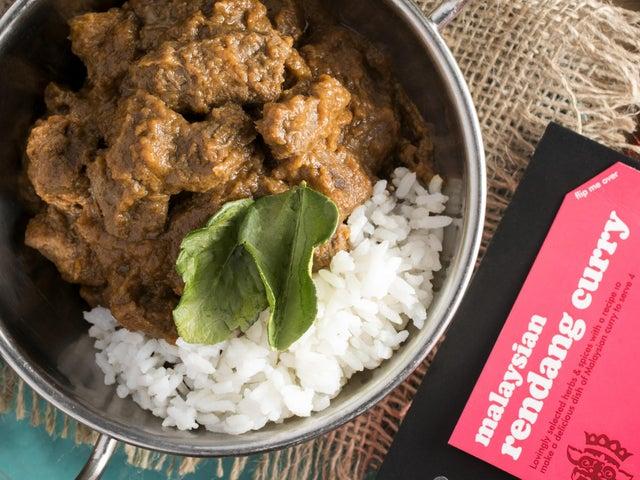
Best: Low calorie curry kit
Back in 1994 Spicentice founder Ketan Varu’s mum used to send him recipes and spices as a student in the UK to remind him of home in India. The idea for Spicentice was born and now the meal kits span dishes from every continent including Greek souvlaki, jerk chicken and char siu ribs, but we’re here to talk about the curries today which vary from Thai, Malay, Indian and far Eastern. The packs contain a few sachets of spices or marinades, shopping list for fresh ingredients (we needed beef, onion, garlic, coconut milk, ginger, limes and a few storecupboard bits) and four or five easy steps to follow. We thought the Malaysian rendang was really tasty with minimal prep aside from blending and frying, and we really enjoyed the family favourite “Methi chicken” pack too. Spicentice market themselves as being largely low calorie, should you care, too. We’d happily purchase again and work our way through some of the more unusual kits and rubs.
Waitrose Cooks Ingredients massaman Thai curry meal kit
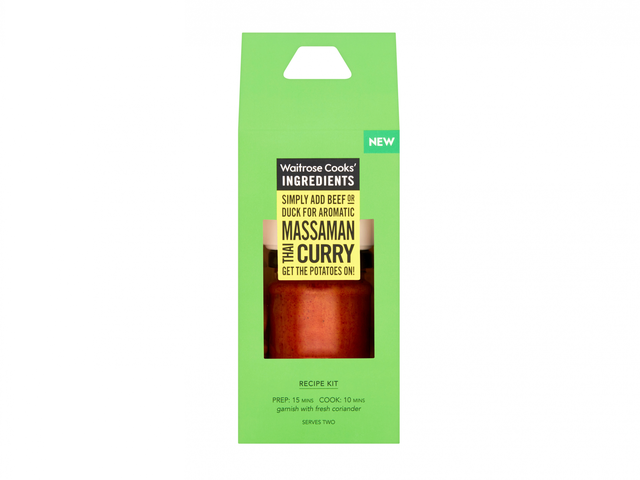
Best: Value
Frankly many of the supermarket-own or mass market kits have been mediocre, but this one stood out to us. For £3.50 and requiring only two further ingredients purchases (beef or duck and a potato), this kit feels like great value and the flavour was far better then a. we’d expected and b. than some of the specialist Thai kits we’d tried. The box contains a standard massaman paste, a packet of whole spices, some handy creamed coconut milk and cashews for sprinkling. There are only three cooking steps and the whole thing is done and dusted after 25 minutes: just add rice for a brilliant commitment-free weeknight dinner, though you might like to throw in some greenery for balance. Again, not one for anyone looking for lessons in how to create a curry from scratch.
Boom Kitchen’s offering stands out for the value, ease of use and the incredible flavours of the curries themselves, but the competition really was tough and we were impressed with all the dishes we tried during testing. Curry is such a broad spectrum, and while Boom Kitchen allow you to recreate Indian restaurant style dishes, we also fell hard for the Punjabi home cooking style of Scotia Spice, and the exotic and complex flavours we created using Hari Hari’s Sri Lankan dishes. For those willing to spend more and those truly committed to the curry cause, we’d highly recommend signing up to The Spicery, especially if you enjoy cooking for groups of people. Whatever your skills in the kitchen, the plethora of excellent curry kits mean it’s never been easier to spice up your life.
Voucher codes
For the latest discounts on food and drink, try the links below:
Looking for a boozy beverage to accompany your curry? We’ve found the best IPAs to suit every palate, from hoppy to mellower ales
